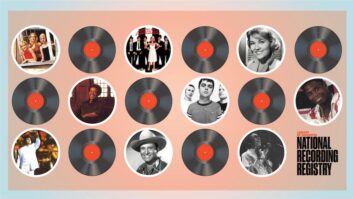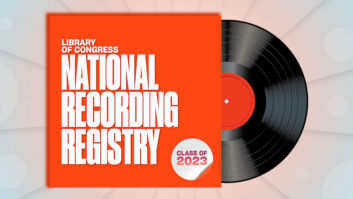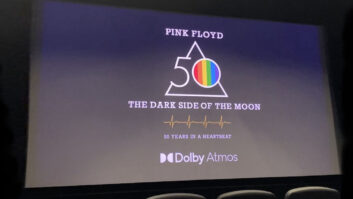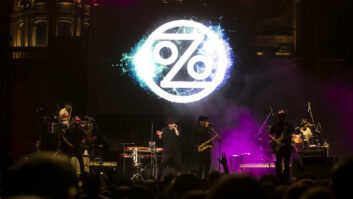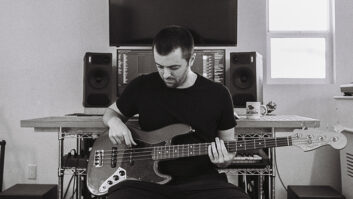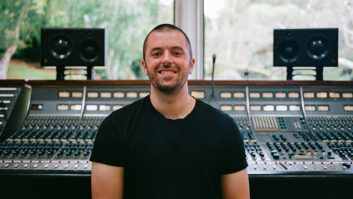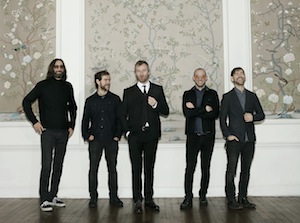
Photo: Deirdre O’Callaghan
For a lot of people, it takes awhile for our records to really sink in,” says Aaron Dessner of the moody Brooklyn rock band The National. “We try to make our records interesting in terms of how the songs unfold and develop—the dynamics—and, of course, Matt’s lyrics usually aren’t that obvious, even when they’re fairly direct.”
That would be Matt Berninger, possessor of the haunting, resonant baritone at the center of The National’s sound, and author—with his wife, Carin Besser—of the at-times opaque lyrics on the band’s latest album, Trouble Will Find Me (on the 4AD label). The music that surrounds that voice is often a hypnotic weave of intricately layered guitars, keyboards, bass and drums, with strings and horns thrown in occasionally for textural effect. The National are masters of the slow build—their nuanced songs often simmer and grow organically, elegantly flowering with a dark, mysterious beauty and propelled by subtle drones. Besides Berninger and guitarist/keyboardist/producer/engineer Dessner, the group consists of Aaron’s multi-instrumentalist twin brother Bryce Dessner (also co-producer/engineer), and another set of brothers, bassist Scott Devendorf and the group’s not-so-secret weapon—the phenomenal drummer Bryan Devendorf.
Since their second album (they’ve made six), the band has worked with producer/engineer/mixer Peter Katis and either recorded or mixed parts of their albums at his Tarquin Studios in Bridgeport, Conn. In 2008, however, Aaron Dessner built a studio in the two-car garage behind his Brooklyn home, and starting with the 2010 album, High Violet, the Dessners have taken a greater role in the recording process. On Trouble Will Find Me, Katis mixed just one tune, with Aaron and Bryce working on the demos and early recording and premixing in the garage studio, then bringing in Montreal-based engineer Marcus Paquin (Arcade Fire, Stars, Local Natives) to be the principal tracking engineer for sessions at Clubhouse, a Neve 8058-equipped room in Rhinebeck, N.Y. (up the Hudson River from Manhattan). Overdubs were at the garage, and except for two songs, it was mixed by Craig Silvey (Yeah Yeah Yeahs, Arcade Fire, Arctic Monkeys) on the Neve 8078 in Studio A at Electric Lady in NYC.
Aaron says they decided to record upstate because “we wanted to isolate ourselves and also try to capture more spontaneity and more interactivity in the underlying performances. We have families, and it’s easier to focus if you distance yourself from your normal life. The living arrangements were really nice, and the land around the studio is so beautiful. We stayed up there for six weeks. It was something we’d never done before, and it ended up being a really special experience for the band.” The band also cut one song and recorded string overdubs at nearby Dreamland Studios in West Hurley, N.Y.
The group’s songs start as wordless demos created in the garage. “We’ll write music that usually has some form and sense of melody and send them to Matt,” Dessner says. “And we’ll send a lot of them—well over 50, for sure—as templates for him to experiment over. Over time he’ll zero in on the ones that are inspiring him, and then we focus on those. As a band we’ll try to arrange the song, work on beats and come up with ideas for textures. But the music develops somewhat separately from the vocals, and then at some point, we’ll start recording vocals.”
“In this case,” adds engineer Paquin, “by the time we were talking about where to record, there were already some scratch vocals, and several songs had been developed.” And though the band’s long stint at Clubhouse found the entire band (plus keyboardist Nick Lloyd) laying down solid basics and other parts, they didn’t hesitate to carry through parts from the Brooklyn demos if they felt they were right for a song—indeed, nearly half of the songs on the album kept the demo as a base.
“We were open to using whatever created the most interesting colors and which played into the emotions of the songs as they intended it,” Paquin comments. “There were a number of songs where we really liked the demo, we re-recorded it to get a better performance or a sonic improvement—and then we came back later and realized the original had a better feeling to it, or sonically there was an interesting quality we preferred.”
Clubhouse turned out to be a great room for Bryan Devendorf’s drums. Besides miking the kit pieces individually, Paquin used a pair of RCA 44 ribbons on the room and a U 47 in front of the drums, through a compressor, “going for a round fatness that, when you blended them with the drums, gave them a center.” The Dessners brought “cases and cases of guitars, and we cycled through many guitars and amps to find the right sonics for each song,” Paquin notes. His main guitar mics were a Beyer 201 and a Royer R-121. Berninger’s lead vocals at Clubhouse were recorded using a Shure SM7B through a Neve 1073 preamp and a bit of 1176 compression, with more captured using a Telefunken U47 tube at a private studio called Kickstand, near the singer’s L.A. home. For harmonies and doubling, Paquin used a Neumann U 87.

After the Clubhouse sessions, action shifted back to the garage and the long process of overdubbing and layering. “It was all about finding the right textures and color shifts and determining what the aesthetic would be,” Dessner says. “We never really talk about it. We just inch closer and closer toward some place that feels like a place we can live with.”
ONLINE EXTRA
More of The National’s Aaron Dessner and engineer Marcus Paquin on the recording of Trouble Will Find Me
On the decision to record at the Clubhouse.
Dessner: “My brother bought a farmhouse about 15 minutes from there. There were a few studios we looked at up there—the main other one was Dreamland, and we did do some recording there, also. The song ‘Fireproof’ was recorded at Dreamland, and all the orchestrations were done there, pretty much. The rest of the recordings were done in my garage again, including a lot of premixing and messing around with sounds. And we chose to mix it in a different way, for variety and a slightly different approach—not because we don’t like working with Peter [Katis]; we love working with Peter, but sometimes you get set in your ways, and it’s good to shake things up a little bit. So we chose to work with Craig Silvey, after some spec mixes with various people, and Craig had a great chemistry with us, and he had a very analog approach I found interesting.”
Paquin: “The reason we went to Dreamland originally is on Day Three of recording at Clubhouse, there were storm warnings, and we were outside having a short break. The trees around us started shaking, and the air turned white, and before we knew it a tornado was heading toward us! We all ran into the studio simultaneously, and about 30 seconds later we watched a tree get split in half and ripped out of the ground. Shortly after that, the power went out and we lost power for about three days. So we spent about two and a half or three days with no power or water, waiting it out. It was still a productive time—acoustic guitars got taken out, parts of songs were fine-tuned and lyrical ideas were tried out. But after a point we wanted to do some recording, so we worked out some studio time at Dreamland and spent a day there before Clubhouse was back up.” (The sting and horn overdubs at Dreamland happened later.)
On using some of the demo recordings on the finished album.
Dessner: “I’d say at least half of this record is the demos—the original music I recorded in my studio. One of Bryce’s demos is on there. Songs like ‘Slipped,’ ‘This Is the Last Time,’ ‘Hard to Find,’ ‘Humiliation,’ ‘Pink Rabbits,’ ‘I Should Live in Salt’—those are all the original recordings. When you’re first developing an idea for a song, there’s a certain spontaneity and casual energy in the performance that can get lost when you actually go to record it. Sometimes they lose their charm. I record things as well as I can in the garage—we have great mics and a lot of great preamps, compressors, amps, guitars and keyboards—but I tend to not worry that much about the sound.”
Where did you get your recording chops?
Dessner: “Mainly trial and error. I peaked over the shoulder of many great engineers, Peter Katis being the most obvious one we worked with for more than a decade, so I know some of his tricks. In a very rudimentary way I can imitate some of them. And I learned a lot from him in terms of mic placement and basic techniques and avoiding overcompressing things. On the opposite side of the spectrum, Sufjan Stevens is a close friend. He self-records everything, and he’s taught me a few unusual things—like, if you want a tambourine to sound reverb-y, put the mic in another room or across the room. There are also some guys down in Philadelphia at a studio called Miner Street that I really like—Brian McTear and Jon Low. Jon worked on this record also. I like his approach to re-amping, and he has a lot of interesting ways of treating things. We like to record things [straight] and then treat them with re-amps and other effects.”
Paquin: “Sufjan Stevens came in for a bunch of days to work on a few songs, especially the ‘Demons.’ He added a few special twists. He brought in a Prophet 8 and played some keyboards, and he also brought in a drum machine. They spent a number of days working through songs and seeing what he could add.”
Are there producers besides Peter Katis who have influenced your recording aesthetic?
Dessner: “The obvious one is Daniel Lanois; definitely some of the hazy elements we use. And John Cale for the drones. A lot of our songs either start with drones or end with drones, or the songs are written so there are one-chord drones that exist through the whole thing. On a song like ‘Fireproof,’ I was definitely thinking of Paul Simon—a contained fingerpicking song that can be played on one instrument that could carry the song. And on ‘Slipped’ I was thinking of ‘Not Dark Yet’ off of [Dylan’s] Time Out of Mind. I like that Lanois-Dylan magical chemistry.”
As producers, do you and your brother Bryce have different specialties or areas of emphasis?
Dessner: “We’re very good collaborators because we grew up collaborating on everything and playing instruments together. We finish each other’s ideas. We’re both decent engineers. I’d say I’m more of a songwriter—I write more of the music and I guess I have maybe a bit more will to push the boulder up the mountain, and Bryce is much more specific with arrangement ideas, because he’s a classical musician. He’ll spend a lot of his time in Sibelius experimenting with different ways to orchestrate something. So a lot of his production work is actually orchestration, whereas mine is working on the whole—how things are coming together, and developing the basic ideas. Then we help each other along, whether its his or mine. It’s very organic and there’s a lot of back and forth. Another way we help each other is when we’re actually tracking guitars or bass or keyboards or whatever, if he’s playing, I’m usually engineering and vice-versa, so we sort of edit each other on the fly. Because of the way we grew up, we can do that and there aren’t any hurt feelings, which means we can move pretty quickly to what we want. We joke that we’re like a two-headed monster when we’re producing.”
The song ‘This is the Last Time’ is a good example of the cool layering you guys do, with all those little parts and the strings and all.
Dessner: “We’re always trying to figure out, how do you make something dynamic? On that one I had these two basslines that existed from the beginning and then everything else was played to that. You want a song to go somewhere and have an arc and have elbows and left turns. That song was fun to make because we tried a lot of things.
“That was probably the most-produced of all the songs, with so many different elements. It was recorded in the garage—even the orchestration was done there and we tripled each [strings] element. Then the guitars in the coda were recorded in Berlin actually when [Bryce and I] were back there last December, staying in a hotel called the Michelberger. We had been in Copenhagen playing with the Copenhagen Philharmonic, because Bryce had written a guitar concerto that he was performing there—we were the soloists. So we went from Copenhagen to Berlin to record, and we did the guitars for ‘Sea of Love’ and ‘This is the Last Time’ there in this big cement room that gave it a nice sound.
“We do a lot of versions of songs and do a lot of parts, and then we throw a lot of it away; carve it away and eventually it’s all about finding the right tone and the right balances, complexity and directness.”
I know you guys like analog a lot. Did you ever record drums to analog tape, as some producers and engineers like to do?
Paquin: “We did do a couple of tracks where we would record the drums on tape, one of which was ‘Hard to Find.’ It’s such a beautiful song and we really spent quite a bit of time on that one getting a drum sound that was unique and which played into the emotional depth of the song. Eventually, after a lot switching out drums and playing with tunings and switching up the miking of the kit, we settled on bouncing the whole tune as it was to tape—without drums—speeding it up and then having Bryan play to the sped-up track. Then we slowed it back down so the drums were much lower, and it really changed the attack of the drums—it softened the attack and rounded out the edges of the drums on that one. It gave the drums and unobtrusive quality that still propelled the song forward once they came in.”
A lot of songs seem to feature a contrast between crisp drums and the more ambient, drone-y stuff.
Paquin: “That’s right. The characteristic traits of their music are the driving force of Bryan’s drumming, along with the sonic beauty and the lyrics Matt is singing, and then this whole orchestration of different instruments and textures . It’s a beautiful thing and it keeps the ear coming back. That was something we were very conscious of—to keep it interesting and beautiful.
“The guys are real masters of finding an idea they know is good and really hunting down that magic combination of elements that gives the listener a visceral experience they want to pull apart and get deeper into. So there was a lot of ‘Let’s try this with a guitar, let’s try this with this kind of keyboard, let’s use piano here,’ before we settled on the final versions of any songs.”
I like all the different piano textures. Some of them sound like upright, some are obviously grand piano. Some are kind of distant-sounding, some more close-up.
Paquin: “We used piano at all of the studios we worked at. The really distant stuff was the piano at Dreamland, with distant miking. Some was the grand piano at Clubhouse, and then we actually used Aaron’s upright Yamaha that he does a lot of his songwriting on and a lot of the demoing on. We ended up shipping that out to Clubhouse.”
What are some of the other keyboards? I hear a lot of organ drone on there.
Paquin: “There’s a lot of Hammond B-3. Also, Aaron had just bought a Korg MS-20 [mini analog synth]. One of my side projects was to really get to know the MS-20, so after the sessions at night I’d disappear and go on YouTube and do tutorials and learn new patches. I’d come in the next day and say ‘Aaron, check this out,’ and he’d ‘yea’ or ‘nay’ it.”
Dessner: “On the song ‘I Should Live in Salt,’ the demo was the acoustic guitar and those somewhat composed, somewhat random MS-20 Korg lines you hear in there—sort of blooming synths—and then everything else was recorded at Clubhouse.”
Were the decisions about the different reverbs used on Matt’s vocals made during the tracking of during Craig Silvey’s mix? Is that an EMT 140 plate I’m hearing?
Dessner: “Actually, Craig doesn’t use any plates at all. He uses spring [reverb] and he also uses this Roland Chorus Echo and some weird Ibanez effects thing he uses. He has his own weird cocktail that he does; and also will use natural overdrive and distortion.”
Paquin: “Craig Silvey’s got an amazing approach to vocals and how he creates a space around them.”
What did you hand over to Craig when it came time to mix?
Paquin: “We made sure the mixes were sitting well as the process went on, so when we handed them over to Craig, everybody had a pretty good idea of where we wanted the balances to be, and Craig was really good at working within the mixes and sort of improving things and adding depth.”


